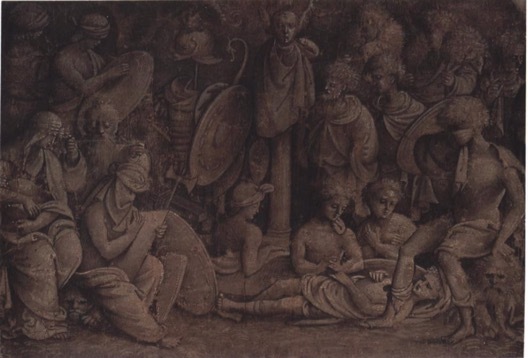Amico Aspertini
The Mourning of a Classical Warrior
Ca. 1503-10
Pen and brown ink, brush with gray, brown and white gouache on light brown paper
25.7 x 37 cm
On loan from the Tobey Collection
Aspertini’s style has been described as manic, a characterization seen in aspects of this small drawing. The subjects, closely crowded together around a column bearing an odd, ass-eared portrait bust, all have exaggerated, wild, scribbled hair, and the crowded gathering includes the severed heads of enemies in the lower corners. This work, loosely inspired by ancient Roman imagery, depicts a scene in which at least fifteen individuals are gathered across a frieze-like space to mourn the young soldier lying dead in the lower right corner. Many of the figures engage in mysterious activities: the man on the left side of the drawing stretches a thread between his spread hands, perhaps the “thread of life”; another figure, in the upper left corner, writes on a shield, possibly inscribing the deeds of the departed. The figures strike a variety of poses; their gestures lead our eyes across the drawing, yet most of them glance or gesture down towards the departed, reminding the viewer of the main focal point.
The subject that inspired the piece is unknown, but Aspertini was probably influenced by densely-figured, horizontally-formatted ancient Roman sarcophagi. The drawing is quite naturalistic; the bodies are represented realistically, and the folds of the togas are convincing as well. Aspertini is known for his façade frescos, building decorations he painted in a monochrome style. Similarly, this dark drawing is created in a technique known as en brunaille, a manner that deploys various shades of brown along with white gouache highlights, intricate linework, and ink hatching. Some scholars believe that this drawing might have been intended as a study for a palace façade or a courtyard because of the particular techniques used within it.
Mary Thalassinos

